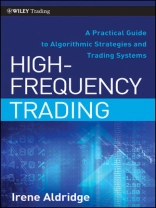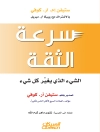A hands-on guide to the fast and ever-changing world of
high-frequency, algorithmic trading
Financial markets are undergoing rapid innovation due to the
continuing proliferation of computer power and algorithms. These
developments have created a new investment discipline called
high-frequency trading.
This book covers all aspects of high-frequency trading, from the
business case and formulation of ideas through the development of
trading systems to application of capital and subsequent
performance evaluation. It also includes numerous quantitative
trading strategies, with market microstructure, event arbitrage,
and deviations arbitrage discussed in great detail.
* Contains the tools and techniques needed for building a
high-frequency trading system
* Details the post-trade analysis process, including key
performance benchmarks and trade quality evaluation
* Written by well-known industry professional Irene Aldridge
Interest in high-frequency trading has exploded over the past
year. This book has what you need to gain a better understanding of
how it works and what it takes to apply this approach to your
trading endeavors.
Daftar Isi
Acknowledgments.
Chapter 1 Introduction.
Chapter 2 Evolution of High-Frequency Trading.
Financial Markets And Technological Innovation.
Evolution Of Trading Methodology.
Chapter 3 Overview of the Business of High-Frequency Trading.
Comparison With Traditional Approaches to Trading.
Market Participants.
Operating Model.
Economics.
Capitalizing a High-Frequency Trading Business.
Conclusion.
Chapter 4 Financial Markets Suitable for High-Frequency Trading.
Financial Markets and Their Suitability for High-Frequency Trading.
Conclusion.
Chapter 5 Evaluating Performance of High-Frequency Strategies.
Basic Return Characteristics.
Comparative Ratios.
Performance Attribution.
Other Considerations in Strategy Evaluation.
Conclusion.
Chapter 6: Orders, Traders and their Applicability to High-Frequency Trading.
Order Types.
Order Distributions.
Conclusion.
Chapter 7: Market Inefficiency and Profit Opportunities at Different Frequencies.
Predictability of Price Moves at High Frequencies.
Conclusion.
Chapter: 8: Searching for High-Frequency Trading Opportunities.
Statistical Properties of Returns.
Linear Econometric Models.
Volatility Modeling.
Nonlinear Models.
Conclusion.
Chapter 9: Working with Tick Data.
Properties of Tick Data.
Quantity and Quality of Tick Data.
Bid-Ask Spreads.
Bid-Ask Bounce.
Modeling Arrivals of Tick Data.
Applying Traditional Econometric Techniques to Tick Data.
Conclusion.
Chapter 10: Trading on Market Microstructure Inventory Models.
Overview of Inventory Trading Strategies.
Orders, Traders and Liquidity.
Profitable Market Making.
Directional Liquidity Provision.
Conclusion.
Chapter 11: Trading on Market Microstructure Information Models.
Measures of Asymmetric Information.
Information-Based Trading Models.
Conclusion.
Chapter 12: Event Arbitrage.
Developing Event Arbitrage Trading Strategies.
What Constitutes an Event?
Forecasting Methodologies.
Tradeable News.
Application of Event Arbitrage.
Conclusion.
Chapter 13: Statistical Arbitrage in High Frequency Settings.
Mathematical Foundations.
Practical Applications of Statistical Arbitrage.
Conclusion.
Chapter 14: Creating and Managing Portfolios of High-Frequency Strategies.
Analytical Foundations of Portfolio Optimization.
Effective Portfolio Management Practices.
Conclusion.
Chapter 15: Back-Testing Trading Models.
Evaluating Point Forecasts.
Evaluating Directional Forecasts.
Conclusion.
Chapter 16: Implementing High-Frequency Trading Systems.
Model Development Lifecycle.
System Implementation.
Testing Trading Systems.
Conclusion.
Chapter 17: Risk Management.
Determining Risk Management Goals.
Measuring Risk.
Managing Risk.
Conclusion.
Chapter 18: Executing and Monitoring High-Frequency Trading.
Executing High-Frequency Trading Systems.
Monitoring High-Frequency Execution.
Conclusion.
Chapter 19: Post-Trade Profitability Analysis.
Post-Trade Cost Analysis.
Post-Trade Performance Analysis.
References.
About the Web Site.
About The Author.
Index.
Tentang Penulis
Irene Aldridge is an expert on the subject of high-frequency
trading. She is currently a Managing Partner and Quantitative
Portfolio Manager at ABLE Alpha Trading, LTD, a proprietary trading
vehicle specializing in high-frequency systematic trading
strategies. Prior to ABLE Alpha, Aldridge worked for various
institutions on Wall Street and in Toronto, including Goldman Sachs
and CIBC. She also taught finance at the University of Toronto. She
holds an MBA from INSEAD, an MS in financial engineering from
Columbia University, and a BE in electric engineering from the
Cooper Union in New York. Aldridge is a frequent speaker at top
industry events and a contributor to academic and practitioner
publications, including the Journal of Trading, E-Forex,
Hedge World, FXWeek, FINalternatives, and Dealing with Technology.
She also appears frequently on business television, including
appearances on CNBC, Fox Business, and The Daily Show with Jon
Stewart. Aldridge has been quoted by Bloomberg LP and other major
business news outlets.












